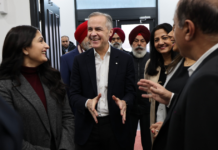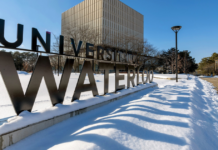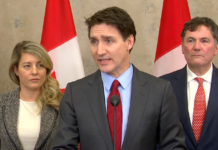A weird story I discussed on True North last month has become weirder still in its descent into tragicomedy.
It concerns growing calls for Quesnel, B.C. Mayor Ron Paull to resign following the discovery that his wife had been handing out free copies of Grave Error: How the Media Misled Us (and the Truth about Residential Schools), an essay collection edited by authors C.P. Champion and Tom Flanagan, a huge Amazon bestseller jointly published by True North and Dorchester Books.
Over 200 people marched outside Quesnel city hall the evening of Apr. 2 before many rushed into a raucous council meeting in this central B.C. city of some 23,000 people.
Three city councillors, several Indigenous bands, and some locals are demanding the mayor of Quesnel resign after his wife’s allegedly hateful book distribution.
As I previously mentioned, the issue of the book’s contents and distribution were addressed during the council’s Mar. 19 meeting, following a letter from the 191-member Lhtako Dene Indian Band expressing outrage over having to defend the existence of the Indian Residential Schools or the findings of the Truth and Reconciliation Commission charged with reporting on the origin, operation, and legacy of the schools.
No, that’s not a typo: this “First Nation” totals 191 people, not 191,000, not 19,100, not even 1,910, all living on Turtle Island, a locale just as fanciful as Gilligan’s Island.
Even the Monty Python crew couldn’t have dreamed up a tragicomedy this bizarre.
The legacy media, acting as stenographers for the city council and Indigenous activist allies, failed to mention that none of Grave Error’s writers or two editors questioned the existence of the Indian Residential Schools or the poor experiences of some of its students, especially those sent there from broken or orphaned homes.
No mention was made either in the many mainstream media stories covering this issue, including the latest Apr. 5 CBC report, that the truth and reconciliation commission’s findings have been roundly criticized as biased, skewed, and unverified in scores of carefully researched articles since its 2015 final report was released.
Nor is there any interest in the just published and truthful views of the respected Catholic News Agency that:
“In the years since the purported discovery (on May 27, 2021), however, questions have been raised as to whether there truly is a mass grave at the site. No remains have ever been discovered on the Kamloops school grounds, and there are no apparent efforts underway to excavate the radar-indicated alleged graves.”
Instead, all the focus has been on undocumented generalizations and emotional outbursts such as those of members of the minuscule Lhtako Dene Indian Band and their Quesnel city council enablers.
The book was unanimously denounced by Paull and the council at their Mar. 19 meeting, when the council reaffirmed its relationship with the Lhtako Dene and formally accepted the findings of the Truth and Reconciliation Commission. In doing so, the mayor figuratively pushed his wife under the bus, naively thinking that this would save his political hide, a cowardly conjugal betrayal now backfiring on him big time.
Since few people on the other side appear to have given the book even a cursory glance, it was possible for Lhtako Dene Chief Clifford Lebrun to declare, “We can no longer work with this mayor, and we will not work with the City of Quesnel until (the) issue has been resolved.”
Translation: fire the mayor or else face the wrath of our 191-person nation.
“We can’t have a community that hands out hate literature and expects people to listen to us and to take it seriously,” he also said.
Personal disclosure: I am the author of three Grave Error essays and consider Chief Lebrun’s statement a libelous slur on my 50 years as a credentialed researcher and writer.
Still, I take some consolation in knowing that writing truthfully about Indigenous issues is like living inside a crazy Monty Python sketch, so I am trying to laugh, rather than cry, about this nasty labelling, a good enough reason to call the whole affair a tragicomedy.
The anger and despair expressed by those who appeared before the city council should not be dismissed as contrived, including Nazko Band Chief Leah Stump’s tearful address to councillors.
“We deserve better than having to come here to prove we went to residential schools, to prove that we were hurt and broken,” she said.
Yes, many genuine tears were shed by hurt people at the Apr. 2 council meeting. But heartfelt emotion is not synonymous with solid empirical proof. What is misunderstood most is that after 1940 nearly all those enrolled in these boarding schools were the product of broken homes, an inexorable product of the colonial contact between Indigenous and Western peoples, a feature the residential schools were established to remedy. More particularly, the schools were an escape from these adversities because there were no orphanages or foster care services where they could be sent instead.
That the book’s essays also employ well-documented historical accounts to successfully challenge the notion that Indigenous children, other than those just referred to, were forced to attend residential schools is likewise incontestable. Nor is there a scintilla of verifiable evidence that the residential school system practiced genocide.
Yes, there were tears and shouts aplenty from victims of what looks like mass hysteria desperately trying to control what you and I can read and discuss, all of it in the name of a one-way “reconciliation” effort, in this case led by a 191-member Lhtako Dene Indian Band ostentatiously calling itself a “First Nation” in a deliberate but wrongheaded effort to subvert the legitimacy of the nation-state called Canada.
Hymie Rubenstein is editor of REAL Indigenous Report and a retired professor of anthropology, the University of Manitoba.





















